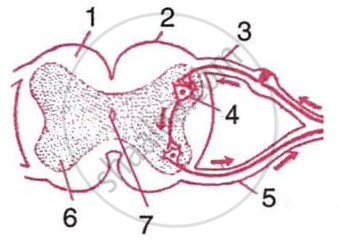Advertisements
Advertisements
Question
Given alongside is a partial diagrammatic representation of a certain phenomenon pertaining to the nervous system.
 |
- Name the parts numbered 1-7.
- Name the phenomenon that the diagram depicts and define it.
- Give the technical term for the point of contact between two nerve cells.
- Name the parts not shown in the diagram that should be included to complete the pathway of the phenomenon.
Solution
-
- White matter
- Spinal cord
- Dorsal root (sensory)
- Association Neuron
- Ventral root
- Gray matter
- Central Canal
- The diagram depicts spinal reflex action.
It is an automatic/quick/immediate, involuntary action in the body brought about by a stimulus. - Synapse
- Receptor, sensory neuron, motor neuron, ·spinal nerve, effector muscles
RELATED QUESTIONS
Which of the following is not a natural reflex action?
A. Knee-jerk
B. Blinking of eyes due to strong light
C. Salivation at the sight of food
D. Sneezing when any irritant enters the nose
The involuntary actions in the body are controlled by :
(a) medulla in forebrain
(b)medulla in hindbrain
(c) medulla in spinal cord
(d) medulla in midbrain
Complete the following statement by choosing the correct alternative from the choice given in bracker:
Reflex action is controlled by
(i) brain (ii) spinal cord
(iii) autonomic (iii) peripheral nervous system
what do we refer to in the nervous system when we say:
Natural and conditioned …………………
State whether the following is simple reflex, conditioned reflex or neither of the two:
Blushing: ……………….
Explain the following term :
Conditioned reflex
Mention, if the following statement is True or False
Reflex action involves brain
Complete the following sentence with appropriate Word
The control of reflex action is through:
State whether the following is simple reflex, conditioned reflex or neither of the two.
Sneezing
